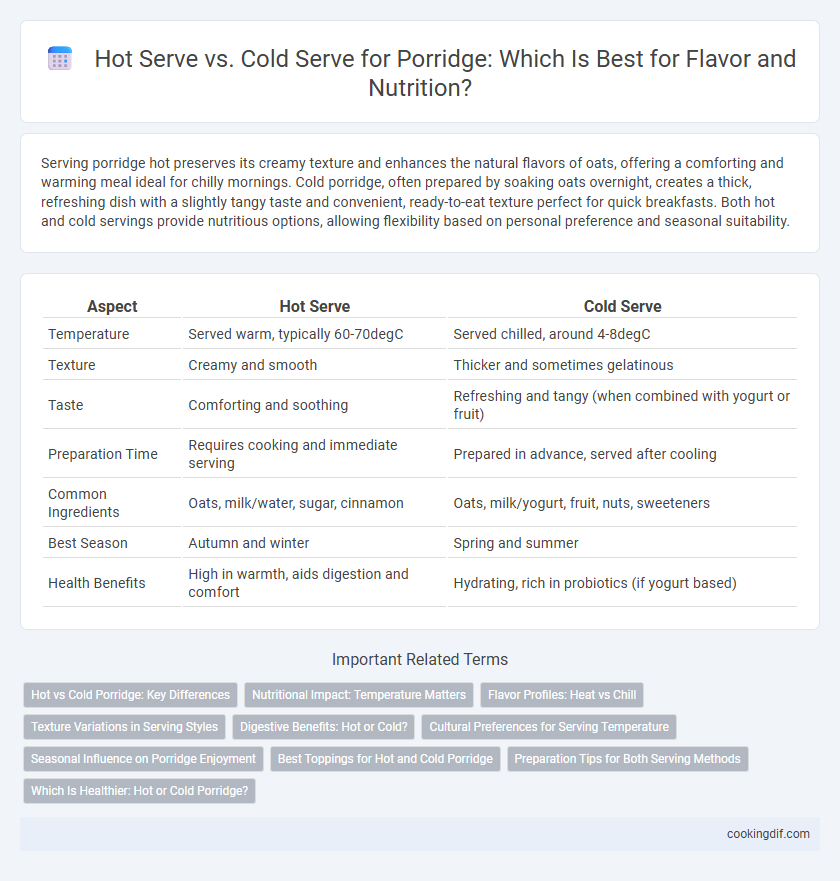Serving porridge hot preserves its creamy texture and enhances the natural flavors of oats, offering a comforting and warming meal ideal for chilly mornings. Cold porridge, often prepared by soaking oats overnight, creates a thick, refreshing dish with a slightly tangy taste and convenient, ready-to-eat texture perfect for quick breakfasts. Both hot and cold servings provide nutritious options, allowing flexibility based on personal preference and seasonal suitability.
Table of Comparison
| Aspect | Hot Serve | Cold Serve |
|---|---|---|
| Temperature | Served warm, typically 60-70degC | Served chilled, around 4-8degC |
| Texture | Creamy and smooth | Thicker and sometimes gelatinous |
| Taste | Comforting and soothing | Refreshing and tangy (when combined with yogurt or fruit) |
| Preparation Time | Requires cooking and immediate serving | Prepared in advance, served after cooling |
| Common Ingredients | Oats, milk/water, sugar, cinnamon | Oats, milk/yogurt, fruit, nuts, sweeteners |
| Best Season | Autumn and winter | Spring and summer |
| Health Benefits | High in warmth, aids digestion and comfort | Hydrating, rich in probiotics (if yogurt based) |
Hot vs Cold Porridge: Key Differences
Hot porridge offers a comforting, creamy texture with enhanced flavor release, making it ideal for a warming breakfast; it typically requires cooking oats with water or milk until thickened. Cold porridge, often prepared as overnight oats, involves soaking oats in liquid without cooking, resulting in a chewier consistency and a more subtle taste. Nutritionally, hot porridge may be easier to digest due to the cooking process, while cold porridge retains more resistant starch, potentially benefiting gut health.
Nutritional Impact: Temperature Matters
Hot-served porridge retains more bioavailable nutrients, including enhanced absorption of beta-glucan, which supports heart health and lowers cholesterol. Cold-served porridge may increase resistant starch content, improving gut health through better prebiotic effects and slower glucose release. Temperature influences porridge's glycemic index, impacting blood sugar regulation and overall nutritional benefits.
Flavor Profiles: Heat vs Chill
Hot-served porridge delivers a rich, creamy texture that enhances the natural nuttiness and sweetness of oats, intensifying warm, comforting flavors. Cold-served porridge, often prepared as overnight oats, offers a tangier, fresher profile with a chewier bite and subtle fermentation notes from ingredients like yogurt or kefir. Temperature variation significantly influences flavor perception, where heat amplifies sweetness and creaminess, while chill sharpens acidity and highlights added fruits or spices.
Texture Variations in Serving Styles
Hot-served porridge offers a creamy and smooth texture due to the heat softening the oats and releasing natural starches, creating a comforting and thick consistency. Cold-served porridge, often prepared as overnight oats, presents a firmer and chewier texture as the oats absorb liquid slowly without heat, preserving a slightly grainy feel. These texture variations influence personal preference and nutritional absorption, with hot porridge facilitating faster digestion and cold porridge providing a refreshing, denser bite.
Digestive Benefits: Hot or Cold?
Hot porridge enhances digestion by stimulating gastric enzymes and improving nutrient absorption through warmth, aiding smoother gastrointestinal function. Cold porridge, such as overnight oats, promotes gut health by increasing resistant starch content, which supports beneficial gut bacteria and improves bowel regularity. Both serving methods offer unique digestive benefits, with hot porridge optimizing enzymatic activity and cold porridge enhancing prebiotic effects.
Cultural Preferences for Serving Temperature
Porridge is traditionally served hot in many cultures such as Scotland and Scandinavia, where it provides a warming, comforting start to the day, especially in colder climates. In contrast, some Southeast Asian countries prefer serving porridge cold or at room temperature, often incorporating fresh fruits or sweeteners to create a refreshing dish suited to warmer weather. These serving temperature preferences reflect regional climate influences and cultural habits surrounding breakfast and meal timing.
Seasonal Influence on Porridge Enjoyment
Hot-served porridge provides comforting warmth and enhanced flavor, making it ideal for colder seasons when body heat retention is crucial. Cold-served porridge, often enjoyed as overnight oats, offers a refreshing and nutritious option better suited for warmer months. Seasonal temperature variations significantly impact porridge consumption preferences, influencing texture perception and overall enjoyment.
Best Toppings for Hot and Cold Porridge
Hot porridge pairs exceptionally well with warming toppings like cinnamon, nutmeg, honey, and fresh berries, which enhance its creamy texture and boost antioxidant intake. Cold porridge, often soaked overnight as overnight oats, benefits from refreshing toppings such as sliced almonds, chia seeds, mango chunks, and a drizzle of maple syrup for added crunch and natural sweetness. Choosing nutrient-dense toppings tailored to temperature not only intensifies flavor but also optimizes the meal's health benefits.
Preparation Tips for Both Serving Methods
For hot porridge, simmer oats with water or milk until creamy, stirring frequently to avoid lumps and achieve a smooth texture. When serving cold porridge, soak oats overnight in milk or yogurt to soften them naturally, enhancing flavor while maintaining a thicker consistency. Use toppings like fresh fruit or nuts to complement the temperature, ensuring balanced taste and texture for both hot and cold preparations.
Which Is Healthier: Hot or Cold Porridge?
Hot porridge retains more heat-sensitive nutrients like antioxidants and vitamins, enhancing their bioavailability compared to cold porridge. Cold porridge, often soaked overnight, preserves resistant starch that supports gut health and improves digestion. Choosing between hot and cold porridge depends on individual nutritional goals, as hot serves boost nutrient absorption while cold serves promote beneficial gut bacteria.
Hot serve vs Cold serve for porridge Infographic

 cookingdif.com
cookingdif.com